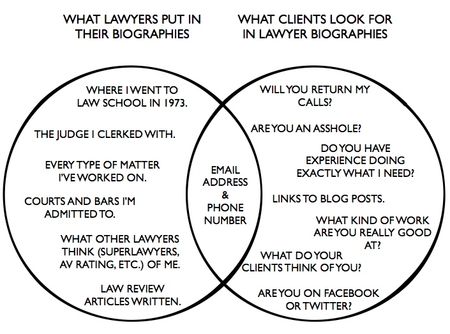Beyond the Basic Biography: How to Craft an Effective Attorney Bio

Essentially, a potential client wants to know with who he or she will be working with—their experience, their knowledge, and their credentials. More importantly, however, the potential client wants to know about you as a person. Surveys have shown that customers buy from people:
1. They like.
2. They trust.
3. They think know a lot.
(in that order)
2. They trust.
3. They think know a lot.
(in that order)
Overcoming the Robotic Lawyer Biography
Unfortunately, most lawyer biographies are generic profiles that highlight the basic information from their resume in paragraph form. The focus is primarily on point three, ignoring points one and two. Matt Homann, founder of LexThink and author of award-winning legal blog [non]billable hour, created this helpful-yet-satirical Venn Diagram of what clients want and what lawyers have on their biographies:

Of course, it’s important to include that information, but the great profiles—the ones that convince clients to ‘call today’—are the ones that build enthusiasm and convince them that you care and that you want to solve their problems. Essentially, people hire people.
Capabilities, Trust, AND Personality
Where you studied, who you’ve worked with, practice areas, publications, and speaking engagements are all the bare necessities. They’re what every other lawyer has on his or her bio page, what other lawyers may find interesting, and what will leave a client’s eyes glazed over after reading ten or eleven biographies. Place these basics on the bottom of the page.
Basics of a Great Attorney Bio Page
Are you ready to humanize your biography? Great! There are a lot of great pieces of advice on humanizing your biography, and they all touch on the same principles:
1. Create an Engaging First Paragraph
How often have you heard the cliché phrase, “first impressions are everything”? Too much? It’s because first impressions are everything, and if it wasn’t true, it wouldn’t be repeated. If you’re the tenth or eleventh attorney in a potential client’s search, the client will have likely seen the exact same information over and over, and will have the same expectations when he or she lands on your site. The client will likely skim your profile and move on to the next biography. This is why an engaging first paragraph is the quickest way to snap them out of the haze of boring information they’ve previously read.
Conversion Insights offers three tips for a great lead-in:
1. What makes you stand out among other attorneys? What are you especially great at? (This doesn’t have to be technical skill—maybe you’re great at explaining things to clients, showing initiative, or helping them understand unexpected fees).
2. What types of legal issues do your clients generally face?
3. Are there any newsworthy legal issues that you have resolved?
2. What types of legal issues do your clients generally face?
3. Are there any newsworthy legal issues that you have resolved?
2. Post a Picture
Again, adding both to the humanization of your biography and the first impression aspect, your picture is an important way to let clients see who they will be working with.
Clients like to put a face with a name, and seeing your face might create an extra level of comfort for a potential client--assuming you are posting the right kind of picture. Lawyerist author Randall Ryder notes that your picture should be fitting for your services:
“If you present yourself as the tough-as-nails criminal defense attorney, your picture should reflect that. If you operate a relaxed and family-friendly office, your picture should reflect that.”
Ryder further notes that hiring a professional photographer is worth the investment, as a grainy, skewed photo will negatively impact a client’s perception of you.
3. Write in Short, Engaging Sentences and Paragraphs
People skim, so you write with that in mind. Buffer, a social media management app, researched the ideal length for everything, and to keep a client engaged, recommends the following (and blogs):
• The ideal Length of a headline is six words
• The ideal width of a paragraph is 40-55 characters/12 words
• Paragraphs should contain no more than 4-5 sentences
• Paragraphs should be four lines or less
• The ideal width of a paragraph is 40-55 characters/12 words
• Paragraphs should contain no more than 4-5 sentences
• Paragraphs should be four lines or less
4. Tell a Story
Everyone loves a story. Not only do they love them, people remember stories much better than a cut-and-dry set of facts. Talk about your experience in a story/narrative format that makes the reader want to read more. Effective marketing will always come back to storytelling because it is the best way to highlight who you are, demonstrate your passion for your work, and reveal your skills in a subtle way. Writing your biography using a narrative will make it easier for a prospect to digest because stories are interesting and memorable.
5. Include Personal Elements
Build rapport with prospective clients by adding a bit of information about what you do in the few hours of spare time you have every week, as well as a few points on why you enjoy doing what you do as an attorney. Conversion Insights suggests addressing the following:
1. What do you like the most about your areas of practice (or the business of law in general)?
2. Which case did you find the most rewarding to work on?
3. What is your favorite law-related quote and why does it resonate with you?
4. What types of community-based events do you participate in?
5. What role does your family play in making you great at what you do?
2. Which case did you find the most rewarding to work on?
3. What is your favorite law-related quote and why does it resonate with you?
4. What types of community-based events do you participate in?
5. What role does your family play in making you great at what you do?
Please note: if you include this information, be sure to supplement it with the kind of information that positions you as a great solution to the reader’s problems as well.
6. Videos
One of the first law firms to include videos into their bio pages was Chicago law firm Levenfeld Pearlstein. Noted by respected marketing expert Ann Handley, author of Content Rules and Everybody Writes, Levenfeld Pearlstein became well respected in the content marketing community (before content marketing was the ‘it’ thing you hear about at any legal marketing talk you attend) for its set of short videos embedded on the profiles of its attorneys.
These short vignettes “speak human,” according to Handley, allowing the attorneys to speak candidly about their professional philosophies and personal viewpoints—showing off their personalities in a creative and wholly unexpected way. All of these tell the story of who the attorney is, why they do what they do, and how they can help the client. Keep this in mind when building out your videos to add to your profile. Additionally, professionalism matters—high quality videos will look much better than shaky iPhone videos.
Additional Considerations
In building your bio, keep the following in mind:
• Speak to your audience: A contract lawyer will have a much different audience than a personal injury lawyer. Knowing this, write in a way that your audience will understand.
• Remember the Robots: There are still great reasons to include the essentials. Building a profile is not only a business development move, it’s an SEO tactic. Remember to fit keywords into your profile without keyword stuffing.
• Make it Easy to Get in Contact: Add your email address, phone number, and if necessary, a simple (name, email, phone) form to get in contact with you.
• Get Social: Include links to your professional social profiles (Twitter, LinkedIn), as well as any blogs or websites, such as Legal Services Link, that you may contribute.
• Use Testimonials: Show what you know. Impress your potential clients with quotes from former clients.
• Remember the Robots: There are still great reasons to include the essentials. Building a profile is not only a business development move, it’s an SEO tactic. Remember to fit keywords into your profile without keyword stuffing.
• Make it Easy to Get in Contact: Add your email address, phone number, and if necessary, a simple (name, email, phone) form to get in contact with you.
• Get Social: Include links to your professional social profiles (Twitter, LinkedIn), as well as any blogs or websites, such as Legal Services Link, that you may contribute.
• Use Testimonials: Show what you know. Impress your potential clients with quotes from former clients.
Conclusion
To build a successful practice, you need to differentiate yourself for your many, many competitors. Building out an informative and engaging, if not entertaining, biography is one way to show clients that you care about them and can help them.
Do you want another way to show clients how you can help them? Legal Services Link was launched to help attorneys connect with and obtain new clients quickly and inexpensively—at the click of a button. Not a Legal Service Link member? Simply create your profile for free at Legal Services Link and let clients come to you!
Get More Clients With Legal Services Link
Create your FREE profile and get listed in our attorney directory to start receiving email notifications of relevant legal projects.

